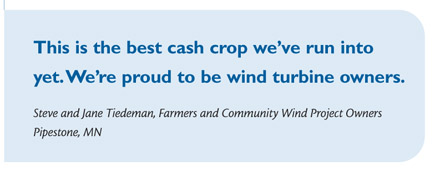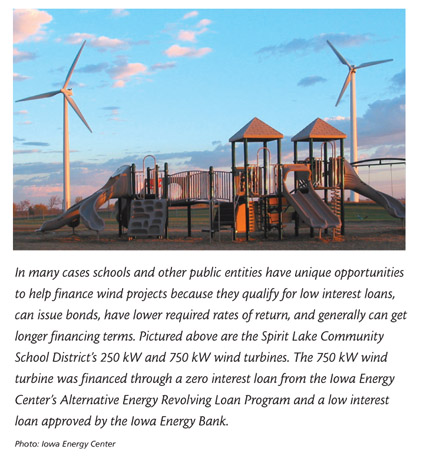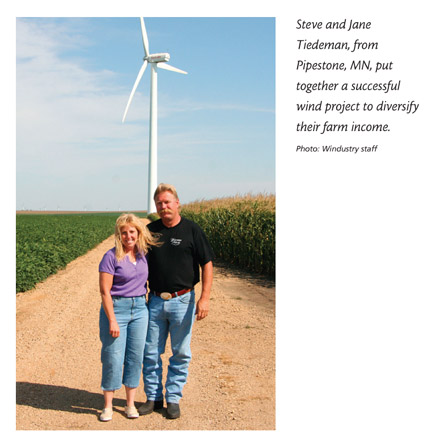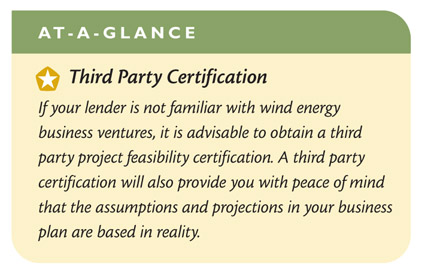Most commercial-scale community wind projects are multi-million dollar investment endeavors that require outside financing assistance. This section will give you some background on how to approach a bank or other financing entity. Loan terms will affect the bottom line of your wind energy project revenue, so understanding the requirements and options for financing your wind development are critical. Getting organized in the beginning will put your project in a much better negotiating position for acquiring favorable financing. With enough due diligence documentation, your project will be less risky and more attractive to a financing entity.
The main topics covered in this section of the Toolbox include:
- Elements of Wind Energy Finance
- Getting a Bank Loan: What will the bank want to know?
- At-a-Glance: Third Party Certification
- Additional Resources for Financing Community Wind
Elements of Wind Energy Finance
Community wind development offers substantial new economic opportunities for rural landowners and communities, with considerable environmental benefits. Although wind power can be lucrative, markets can also be competitive and the margins can be tight. The process for securing financing can be much more challenging for local communities than for a large wind development firm.
As with any investment, wind energy projects require research and a fundamental understanding of the risks, costs, and benefits involved. A community wind developer needs to have a working knowledge of how this investment will translate throughout the entire project, from the initial resource assessment through operation and maintenance at year 20 and beyond.
![]() Windustry’s “Know Your Economics” fact sheet provides a good introduction to economic issues with commercial-scale wind development.
Windustry’s “Know Your Economics” fact sheet provides a good introduction to economic issues with commercial-scale wind development.
Financial Viability
The cost to buy, install, and operate the wind turbine must be able to be offset by the value of energy that can be produced at a particular site. Key variables that can impact the financial viability of a wind farm include:
- Quality of the wind resource (see section of the Toolbox on "Wind Resource Assessment")
- Price and availability of the turbines
- Installation costs
- Availability of incentives and other forms of support for your project
- Distance the power needs to be transported
- Selling price of the power and renewable energy credits
- Cost of financing

Equity and Debt
In many cases, developing a community wind project necessitates requesting a loan from a bank, much as building a new ethanol production facility does. Loan terms for the debt vary, but typically are 10-15 years for conventional bank loans and up to 20 years for bond financings. The equity investment in a project is the amount of capital that is not borrowed, but is invested directly into the project upfront. This may come from private savings or direct investment by members of a cooperative, partnership, or LLC that is interested in obtaining a desired rate of return from the project’s ongoing revenues.

![]() “Financing Community Wind: A Handbook by the Environmental Law and Policy Center” is a good resource on the ins-and-outs of financing wind development. It includes a comprehensive section on “Sourcing Equity and Debt” that covers:
“Financing Community Wind: A Handbook by the Environmental Law and Policy Center” is a good resource on the ins-and-outs of financing wind development. It includes a comprehensive section on “Sourcing Equity and Debt” that covers:
- Finding an Equity Partner
- Arranging Debt Financing (Local Lenders, Regional Agricultural Lenders, and Commercial Banks, Commercial Finance, and Vendor Financing)
- Debt Structuring
- Getting the Project Financed
Getting a Bank Loan:What will the bank want to know?
Some banks and financial institutions in the Midwest have experience with the wind industry and are comfortable financing wind projects. However, if wind energy is new to your area, local banks might be wary or have a lot questions about your plans. This section outlines the basic information you should have available before approaching a bank for a loan.
Detailed Cost and Production Estimates
A lender will want an overview of your project, including detailed cost estimates (written quotes for equipment, interconnection, installation, operation, etc.) and a legal description of the proposed project site, including aerial photos and plat drawings if possible. You also will need detailed budgets of project expenses and income (monthly for at least 24 months, and annually for 10-20 years). See the section above on "Wind Resource Assessment" as well as the "Costs" section for more detailed discussion.
Other due diligence documentation requirements could include:
- Existing and pro forma financial statements
- How and to what level the project will be capitalized
- Plans for using state and federal incentives
- Legal ownership structure
- Background information on majority owners
- Personal financial statements (based on capitalization)
- Listing of all required contracts, permits and easements, and your progress toward obtaining them
- Copy of proposed power purchase agreement
- Risk mitigation plans
- Construction management plans
- Ongoing management and extended warranties plans
- Insurance coverage, including property/casualty liability and business interruption
Credit Guidelines
Many lenders require a minimum equity contribution of 30 percent of the project costs. The term note is typically amortized over 10 years with quarterly or yearly payments. The interest rate on the loan is important and can make the difference between a project that makes a profit and one that simply breaks even. It is important to know what rate of return is foregone by investing the money in the turbine project to determine changes in tax payments.
Evaluation
The lender will evaluate your loan application based on the following criteria:
- Thoroughness and accuracy of your business plan;
- The validity and strength of your cash flow and financial statements;
- Qualifications of your governing board
- Adequate capital secured for the project; and
- A legal review of contracts, permits, and easements.
- Whether loan guarantee is available
Concerns a lender might have about financing wind projects include:
- The availability of equity capital;
- The certainty and stability of power purchase contracts and power purchasing entity;
- The stability and availability of state and national incentives;
- The stability of the market for wind energy; and,
- The availability of proven expertise in wind project design.
Individuals and groups who are interested in developing a wind project are strongly advised to seek expert financial advice as they evaluate potential sites and financial scenarios.
Other means of obtaining debt financing such as bond financing are starting to be used in the wind industry as a low-cost and longer term financing alternative. Bond financing requires due diligence documentation similar to that required by conventional banks.
Public Project Financing – Clean Renewable Energy Bonds (CREBs)
Clean Renewable Energy Bonds have been available to entities that are not eligible for the production tax credit (PTC) due to their non-taxable status, including state and local governments, rural electric cooperatives, Native American tribal governments, and public and private non-profit organizations. After the bonds are issued, their interest is paid by the federal government in the form of tax credits, creating an interest-free source of financing. The IRS received over $2 billion in applications for the initial $800 million available. An additional $400 million in financing authority was issued in late 2006 with a deadline of July 13th 2007 for applications. Due to problems in Congress, the program has gone unfunded in recent years.
CREBs and other tax incentives are discussed further in the "Tax Incentives" section of this Toolbox.

Terms and numbers contained within the document are not to be construed as typical project costs with the rapid rate at which the wind industry is evolving. Different financing companies will have differing terms for lending to a wind energy project. To find out specific terms for various lending institutions, you should contact them directly.

